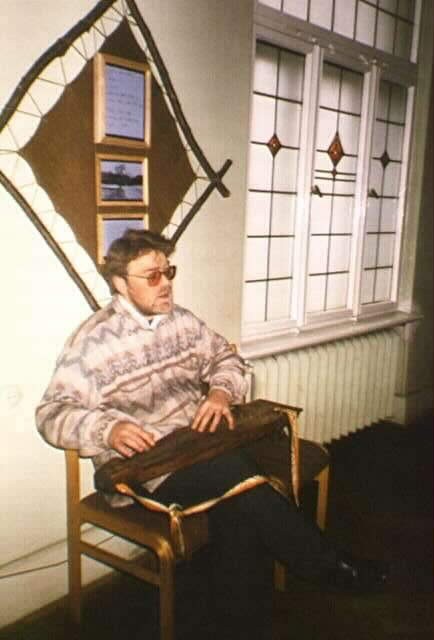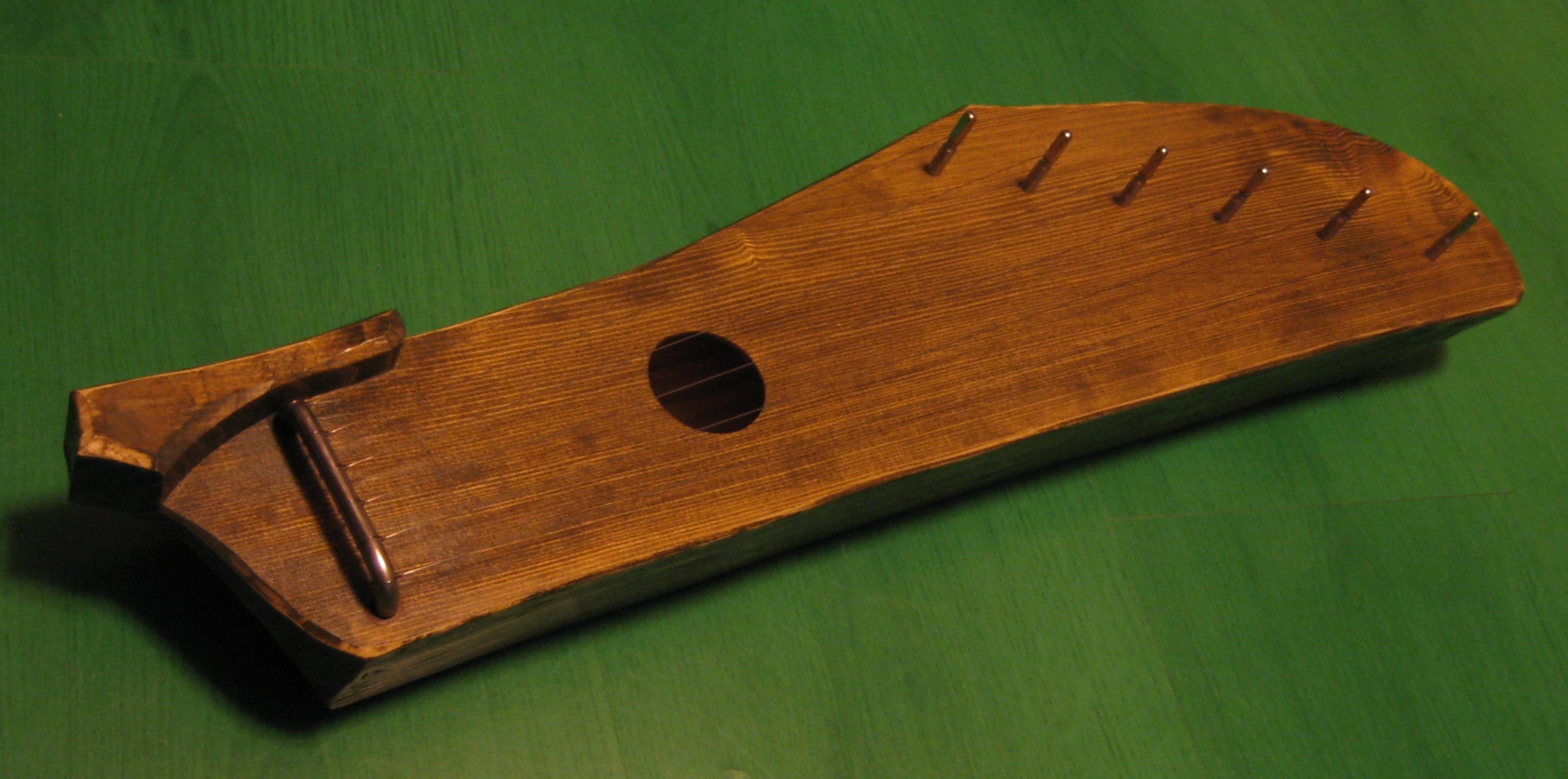|
Plucked String Instrument
Plucked string instruments are a subcategory of string instruments that are played by plucking the strings. Plucking is a way of pulling and releasing the string in such a way as to give it an impulse that causes the string to vibrate. Plucking can be done with either a finger or a plectrum. Most plucked string instruments belong to the lute family (such as guitar, bass guitar, mandolin, banjo, balalaika, sitar, pipa, etc.), which generally consist of a resonating body, and a neck; the strings run along the neck and can be stopped at different pitches. The zither family (including the Qanún/kanun, autoharp, kantele, gusli, kannel, kankles, kokles, koto, guqin, gu zheng and many others) does not have a neck, and the strings are stretched across the soundboard. In the harp family (including the lyre), the strings are perpendicular to the soundboard and do not run across it. The harpsichord does not fit any of these categories but is also a plucked string instrument, as its ... [...More Info...] [...Related Items...] OR: [Wikipedia] [Google] [Baidu] |
Neck (music)
The neck is the part of certain string instruments that projects from the main body and is the base of the fingerboard, where the fingers are placed to stop the strings at different pitches. Guitars, banjos, ukuleles, lutes, the violin family, and the mandolin family are examples of instruments which have necks. Necks are also an integral part of certain woodwind instruments, like for instance the saxophone. The word for neck also sometimes appears in other languages in musical instructions. The terms include ''manche'' (French), ''manico'' (Italian), and ''Hals'' (German). Guitar The neck of a guitar includes the guitar's frets, fretboard, tuners, headstock, and truss rod. The wood used to make the fretboard will usually differ from the wood in the rest of the neck. The bending stress on the neck is considerable, particularly when heavier gauge strings are used (see Strings and tuning), and the ability of the neck to resist bending (see Truss rod) is important to the gu ... [...More Info...] [...Related Items...] OR: [Wikipedia] [Google] [Baidu] |
Lyre
The lyre () is a stringed musical instrument that is classified by Hornbostel–Sachs as a member of the lute-family of instruments. In organology, a lyre is considered a yoke lute, since it is a lute in which the strings are attached to a yoke that lies in the same plane as the sound table, and consists of two arms and a crossbar. The lyre has its origins in ancient history. Lyres were used in several ancient cultures surrounding the Mediterranean Sea. The earliest known examples of the lyre have been recovered at archeological sites that date to c. 2700 BCE in Mesopotamia. The oldest lyres from the Fertile Crescent are known as the eastern lyres and are distinguished from other ancient lyres by their flat base. They have been found at archaeological sites in Egypt, Syria, Anatolia, and the Levant. The round lyre or the Western lyre also originated in Syria and Anatolia, but was not as widely used and eventually died out in the east c. 1750 BCE. The round lyre, called so fo ... [...More Info...] [...Related Items...] OR: [Wikipedia] [Google] [Baidu] |
Harp
The harp is a stringed musical instrument that has a number of individual strings running at an angle to its soundboard; the strings are plucked with the fingers. Harps can be made and played in various ways, standing or sitting, and in orchestras or concerts. Its most common form is triangular in shape and made of wood. Some have multiple rows of strings and pedal attachments. Ancient depictions of harps were recorded in Current-day Iraq (Mesopotamia), Iran (Persia), and Egypt, and later in India and China. By medieval times harps had spread across Europe. Harps were found across the Americas where it was a popular folk tradition in some areas. Distinct designs also emerged from the African continent. Harps have symbolic political traditions and are often used in logos, including in Ireland. History Harps have been known since antiquity in Asia, Africa, and Europe, dating back at least as early as 3000 BCE. The instrument had great popularity in Europe during the ... [...More Info...] [...Related Items...] OR: [Wikipedia] [Google] [Baidu] |
Gu Zheng
The zheng () or gu zheng (), is a Chinese plucked zither. The modern guzheng commonly has 21, 25, or 26 strings, is long, and is tuned in a major pentatonic scale. It has a large, resonant soundboard made from ''Paulownia'' wood. Other components are often made from other woods for structural or decorative reasons. Guzheng players often wear fingerpick made from materials such as plastic, resin, tortoiseshell, or ivory on one or both hands. Strings There are nylon steel strings, steel strings, silk strings, etc., depending on the genre. Now, the most common guzheng is 21 strings guzheng. The high-pitched strings of the guzheng are close to the player, and the low-pitched strings are on the opposite side. The strings' order from the inside to the outside is 1 to 21. The guzheng is ancestral to several other Asian zithers such as the Japanese koto, the Korean gayageum and ajaeng, Mongolian yatga, the Vietnamese đàn tranh, the Sundanese kacapi, and the Kazakhstan jetig ... [...More Info...] [...Related Items...] OR: [Wikipedia] [Google] [Baidu] |
Guqin
The ''guqin'' (; ) is a plucked seven-string Chinese musical instrument. It has been played since ancient times, and has traditionally been favoured by scholars and literati as an instrument of great subtlety and refinement, as highlighted by the quote "a gentleman does not part with his ''qin'' or '' se'' without good reason," as well as being associated with the ancient Chinese philosopher Confucius. It is sometimes referred to by the Chinese as "the father of Chinese music" or "the instrument of the sages". The ''guqin'' is not to be confused with the '' guzheng'', another Chinese long stringed instrument also without frets, but with moveable bridges under each string. Traditionally, the instrument was simply referred to as the "''qin''" (琴) but by the twentieth century the term had come to be applied to many other musical instruments as well: the ''yangqin'' hammered dulcimer, the ''huqin'' family of bowed string instruments, and the Western piano (''gangqin'' (钢琴) ... [...More Info...] [...Related Items...] OR: [Wikipedia] [Google] [Baidu] |
Koto (musical Instrument)
The is a Japanese plucked half-tube zither instrument, and the national instrument of Japan. It is derived from the Chinese and , and similar to the Mongolian , the Korean and , the Vietnamese , the Sundanese and the Kazakhstan . Koto are roughly in length, and made from Paulownia wood (''Paulownia tomentosa'', known as ). The most common type uses 13 strings strung over movable bridges used for tuning, different pieces possibly requiring different tuning. 17-string koto are also common, and act as bass in ensembles. Koto strings are generally plucked using three fingerpicks (), worn on the first three fingers of the right hand. Names and types The character for ''koto'' is , although is often used. However, (''koto'') is the general term for all string instruments in the Japanese language,(jaKotobank koto/ref> including instruments such as the , , , , , and so on. When read as , it indicates the Chinese instrument . The term is used today in the same way. The term ... [...More Info...] [...Related Items...] OR: [Wikipedia] [Google] [Baidu] |
Kokles
Kokle (; ltg, kūkle) or historically kokles (''kūkles'') is a Latvian plucked string instrument (chordophone) belonging to the Baltic box zither family known as the Baltic psaltery along with Lithuanian kanklės, Estonian kannel, Finnish kantele, and Russian krylovidnye gusli. The first possible kokles related archaeological findings in the territory of modern Latvia are from the 13th century, while the first reliable written information about kokles playing comes from the beginning of the 17th century. The first known kokles tune was notated in 1891, but the first kokles recordings into gramophone records and movies were made in 1930s. Both kokles and kokles playing are included in the Latvian Culture Canon. Etymology According to Finnish linguist Eino Nieminen, the name of the instrument, along with the names of most of its neighbouring counterparts (Lithuanian ''kanklės'', Finnish ''kantele'', Estonian ''kannel'' and Livonian ''kāndla''), possibly comes from the p ... [...More Info...] [...Related Items...] OR: [Wikipedia] [Google] [Baidu] |
Kannel (instrument)
Kannel () is an Estonian plucked string instrument (chordophone) belonging to the Baltic box zither family known as the Baltic psaltery along with Finnish kantele, Latvian kokles, Lithuanian kanklės, and Russian gusli. The Estonian kannel has a variety of traditional tunings. In Estonia, studying the kannel has made a resurgence after some years of decline. (in Estonian) Etymology According to Finnish linguist Eino Nieminen, the name of the instrument, along with the names of most of its neighbouring counterparts (Finnish ''kantele'', L ...[...More Info...] [...Related Items...] OR: [Wikipedia] [Google] [Baidu] |
Gusli
''Gusli'' ( rus, гусли, p=ˈɡuslʲɪ) is the oldest East Slavic multi-string plucked instrument, belonging to the zither family, due to its strings being parallel to its resonance board. Its roots lie in Veliky Novgorod in Novgorodian Rus'. It may have a connection to the Byzantine form of the Greek kithara, which in turn derived from the ancient lyre, or might have been imported from Western and Central Europe during the Middle Ages, when the zither had immense popularity. It has its relatives in Europe and throughout the world: kantele in Finland, kannel in Estonia, kanklės in Lithuania, kokles in Latvia, Zither in Germany, citera in the Czech Republic, psalterium in France and so on... Furthermore, the kanun has been found in Arabic countries, and the autoharp, in the United States. It is also related to such ancient instruments as Chinese gu zheng, which has a thousand-year history, and its Japanese relative koto. A stringed musical instrument called is listed as ... [...More Info...] [...Related Items...] OR: [Wikipedia] [Google] [Baidu] |
Kantele
A kantele () or kannel () is a traditional Finnish and Karelian plucked string instrument (chordophone) belonging to the south east Baltic box zither family known as the Baltic psaltery along with Estonian kannel, Latvian kokles, Lithuanian kanklės and Russian gusli. Construction Small kantele Modern instruments with 15 or fewer strings are generally more closely modeled on traditional shapes, and form a category of instrument known as small kantele, in contrast to the modern concert kantele. The oldest forms of kantele have five or six horsehair strings and a wooden body carved from one piece; more modern instruments have metal strings and often a body made from several pieces. The traditional kantele has neither bridge nor nut, the strings run directly from the tuning pegs to a metal bar (''varras'') set into wooden brackets (''ponsi''). Though not acoustically efficient, this construction is part of the distinctive sound of the instrument. The most typical and tradi ... [...More Info...] [...Related Items...] OR: [Wikipedia] [Google] [Baidu] |








